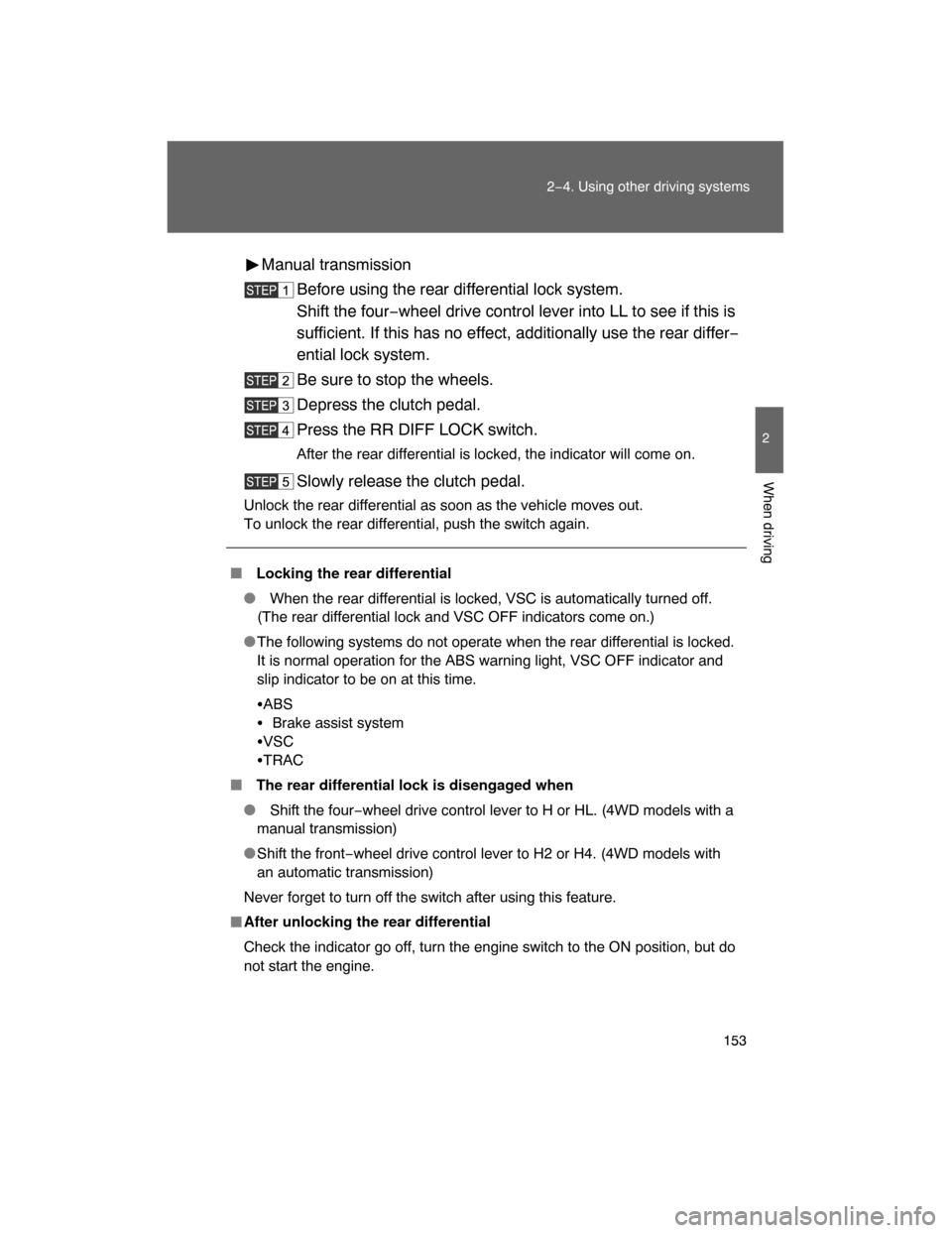Page 140 of 400

142 2−4. Using other driving systems
� Sensor detection information
� Certain vehicle conditions and the surrounding environment may affect
the ability of a sensor to correctly detect an obstacle. Particular instances
where this may occur are listed below.
�There is dirt, snow or ice on a sensor.
�A sensor is frozen.
�A sensor is covered in any way.
�The vehicle is leaning considerably to one side.
�On an extremely bumpy road, on an incline, on gravel, or on grass.
�The vicinity of the vehicle is noisy due to vehicle horns, motorcycle
engines, air brakes of large vehicles, or other loud noises producing
ultrasonic waves.
�There is another vehicle equipped with parking assist sensors in the
vicinity.
�A sensor is coated with a sheet of spray or heavy rain.
�The vehicle is equipped with a fender pole or radio antenna.
�A bumper or sensor receives a strong impact.
�The vehicle is approaching a tall or right−angled curb.
�In harsh sunlight or intense cold weather.
�The area directly under the bumpers is not detected.
Objects lower than the sensors or thin stakes etc. may be detected ini−
tially, but as they draw closer, they may cease to be detected.
�A towing hitch is mounted to the vehicle.
�A non−genuine Toyota suspension (lowered suspension etc.) is
installed.
In addition to the examples above, there are instances in which, because of
their shapes, signs and other objects may be judged by a sensor to be closer
than they are.
� The shape of the obstacle may prevent a sensor from detecting it. Pay
particular attention to the following obstacles:
�Wires, fences, ropes, etc.
�Cotton, snow and other materials that absorb radio waves
�Sharply−angled objects
�Low obstacles
�Tall obstacles with upper sections projecting outwards in the direction
of your vehicle
Page 147 of 400

149
2−4. Using other driving systems
2
When driving
� When the rear differential is locked
(vehicles with the rear differential
lock system)
The active traction control system is activated only when the vehicle speed
is less than 4 mph (6 km/h).
�Sounds and vibrations caused by the active traction control system
�A sound may be heard from the engine compartment when the engine is
started or just after the vehicle begins to move. This sound does not indi−
cate that a malfunction has occurred in the system.
� Vibrations may be felt through the vehicle body and steering. It may
occur when the system is operating.
�If the brake system overheats
The system will cease operation and a buzzer will sound to alert the driver.
Stop the vehicle in a safe place. (There is no problem with continuing normal
driving.)
CAUTION
� The active traction control system may not operate effectively when
Directional control and power may not be achievable while driving on slip−
pery road surfaces, even if the active traction control system is operating.
Do not drive the vehicle in conditions where stability and power may be lost.
Page 148 of 400
150
2−4. Using other driving systems
AUTO LSD system (2WD models)
When the AUTO LSD system is operating
If the rear wheels spin, the slip
indicator flashes to indicate that
the AUTO LSD system have
been controlled the spinning of
the rear wheels.
The AUTO LSD system aids tractio n by using the traction control
system to control engine performance and braking when one of the
rear wheels begins to spin.
The system should be used only wh en wheel spinning occurs in a
ditch or rough surface.
The system is activated when driv ing at a speed under 62 mph (100
km/h).
This system is effective in case one of the rear wheels is spinning.
Press the AUTO LSD switch
to turn on the system.
At this time, the AUTO LSD
indicator will come on.
To turn off the system, push
the switch again.
If the engine is turned off while
the AUTO LSD indicator is on
and then restarted, the indica−
tor will turn off automatically.
Page 151 of 400

153
2−4. Using other driving systems
2
When driving
Manual transmission
Before using the rear differential lock system.
Shift the four−wheel drive control lever into LL to see if this is
sufficient. If this has no effect, additionally use the rear differ−
ential lock system.
Be sure to stop the wheels.
Depress the clutch pedal.
Press the RR DIFF LOCK switch.
After the rear differential is locked, the indicator will come on.
Slowly release the clutch pedal.
Unlock the rear differential as soon as the vehicle moves out.
To unlock the rear differential, push the switch again.
� Locking the rear differential
� When the rear differential is locked, VSC is automatically turned off.
(The rear differential lock and VSC OFF indicators come on.)
�The following systems do not operate when the rear differential is locked.
It is normal operation for the ABS warning light, VSC OFF indicator and
slip indicator to be on at this time.
�ABS
�Brake assist system
�VSC
�TRAC
� The rear differential lock is disengaged when
� Shift the four−wheel drive control lever to H or HL. (4WD models with a
manual transmission)
�Shift the front−wheel drive control lever to H2 or H4. (4WD models with
an automatic transmission)
Never forget to turn off the switch after using this feature.
�After unlocking the rear differential
Check the indicator go off, turn the engine switch to the ON position, but do
not start the engine.
Page 153 of 400
155
2−4. Using other driving systems
2
When driving
Clutch star t cancel switch (vehicles with a manual transmission)
� Clutch start system
The system is designed to keep the starter motor from operating if the clutch
pedal is not depressed all the way down. The switch allows the vehicle to be driven out of difficult situations
by cranking the engine with the clutch engaged.
Never use the switch for normal engine starting. Be sure to follow the
starting procedure. ( P. 114)
Press the CLUTCH START
CANCEL switch to cancel the
clutch start system with the
engine switch is turned to the
ON position.
The indicator comes on when
the clutch start system is can−
celed.
The clutch start cancel switch
is automatically turned off
when the engine switch is
turned off.
Page 155 of 400
157
2−4. Using other driving systems
2
When driving
To disable VSC
If the vehicle gets stuck in fresh snow or mud, VSC may reduce
power from the engine to the wheels. You may need to turn the sys−
tem off to enable you to rock the vehicle in order to free it.
Vehicles with rear differential lock system
Press the RR DIFF LOCK
switch.
The rear differential lock and VSC
OFF indicators should come on.
Push the switch again to turn the
system back on.
4WD models with an automatic transmission
Shift the front−wheel drive control
lever to H4 or L4.
The four−wheel drive and VSC
OFF indicators should come on.
Shift the lever to H2, turn the sys−
tem back on.
4WD models with a manual transmission
Shift the four−wheel drive control
lever to HL or LL.
The center differential lock and
VSC OFF indicators should come
on.
Shift the lever to H, turn the sys−
tem back on.
Page 156 of 400
158 2−4. Using other driving systems
� Sounds and vibrations caused by
the ABS, TRAC, VSC and brake
assist system
�A sound may be heard from the engine compartment when the engine is
started or just after the vehicle begins to move. This sound does not indi−
cate that a malfunction has occurred in any of these systems.
� Any of the following conditions may occur when the above systems are
operating. None of these indicates that a malfunction has occurred.
�Vibrations may be felt through the vehicle body and steering.
�A motor sound may be heard after the vehicle comes to a stop.
�The brake pedal may pulsate slightly after the ABS is activated.
�The brake pedal may move down slightly after the ABS is activated.
� If the brake system overheats
TRAC will cease operation and a buzzer will sound to alert the driver. Stop
the vehicle in a safe place. (There is
no problem with continuing normal driv−
ing.)
Page 162 of 400

164 2−5. Driving information
NOTICE
� To prevent the water damage
� Take all necessary safety measures to ensure that water damage to the
engine or other components does not occur.
Water entering the engine air intake will cause severe engine damage.
�Water entering the automatic transmission will cause deterioration in shift
quality, locking up of your transmission accompanied by vibration, and ulti−
mately damage.
� Water can wash the grease from wheel bearings, causing rusting and pre−
mature failure, and may also enter the differentials, transmission and
transfer case, reducing the gear oil’s lubricating qualities.
� When you drive through water
If driving through water, such as when crossing shallow streams, first check
the depth of the water and the bottom of the river bed for firmness. Drive
slowly and avoid deep water.
� Inspection after off�road driving
� Sand and mud that has accumulate
d in brake drums and around brake
discs may affect braking efficiency and may damage brake system compo−
nents.
� Always perform a maintenance inspection after each day of off−road driv−
ing that has taken you through rough terrain, sand, mud, or water. For
scheduled maintenance information, refer to the “Scheduled Maintenance
Guide” or “Owner ’s Manual Supplement”.